The Rise of the Hybrid Work: Where Tech, Teams, and Tools Converge
Discover how hybrid work evolved, its core challenges, and the role of technology, AI, and advanced tools in making flexible work successful and secure.
Not long ago, “work” had a single address – the office. You’d grab your coffee, commute through traffic, and spend eight hours (or more) at your desk. That was the routine. Then, almost overnight, everything changed. Our dining tables became desks, and video calls replaced conference rooms.
The pandemic didn’t just shake things up; it rewrote the rulebook. Remote work proved the power of flexibility, and now hybrid work is taking center stage. It sounds ideal, but here’s the truth: making hybrid work work isn’t simple. It’s about more than where people sit; it’s about how teams communicate, how projects move forward, and which tools tie it all together.
In this article, we’ll explore how hybrid work began, why it’s here to stay, the challenges it brings, and how the right mix of technology, teamwork, and tools can make it a success.
A Look Back: The Shift to Hybrid Work
For years, work meant one place: the office. Then the pandemic in 2020 changed everything. Remote work became a necessity, and suddenly dining tables turned into desks, and video calls replaced meeting rooms.
What began as an emergency revealed a truth: flexibility works. Productivity held strong, and employees valued the freedom. This sparked a big question: Do we really need to be in the office every day?
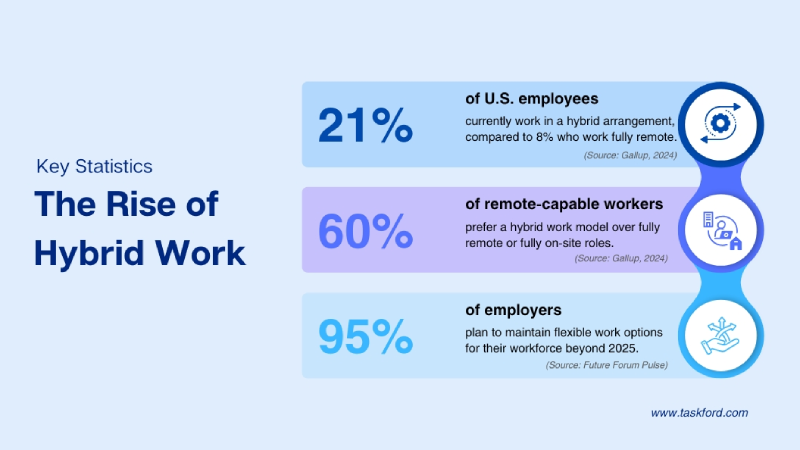
That question gave rise to hybrid work, a model that combines the comfort of home with the collaboration of the office. Today, 21% of U.S. employees work in a hybrid setup, and 60% of remote-capable workers say they prefer it. Businesses agree, with 95% planning to keep flexible options in place (source: Gallup).
Office-remote combination is no longer a trend. It is shaping the future of work. But success requires more than splitting time between home and the office. It calls for new ways to communicate, manage projects, and choose tools that keep teams connected and productive.
The Evolution of a Hybrid Work
So, what is hybrid work? It’s a work model that allows employees to split their time between home and the office. It combines the comfort and focus of working remotely with the collaboration and connection of working in person.
This approach didn’t appear overnight. It started during the pandemic when companies had to switch to remote work almost instantly. At first, it was just a quick solution to keep businesses running. But something interesting happened – people stayed productive, employees enjoyed greater flexibility, and many companies realized they could hire talent from anywhere.
When offices began reopening, the question was clear: should everyone return to the old way of working? For most organizations, the answer was no. Employees wanted flexibility, and businesses saw benefits like lower costs and access to a wider talent pool. This is how the work-from-anywhere model evolved from a temporary fix to a sustainable, long-term strategy.
Now, flexible work is redefining workplace strategies; offices are built for collaboration, digital tools are essential, and managers prioritize results over location. Success, however, depends on clear communication, the right technology, and a connected culture.
Core Challenges in Hybrid Work
Hybrid workplace promises flexibility, but making it work is not simple. Organizations face several challenges that can impact productivity and team morale if not addressed properly.
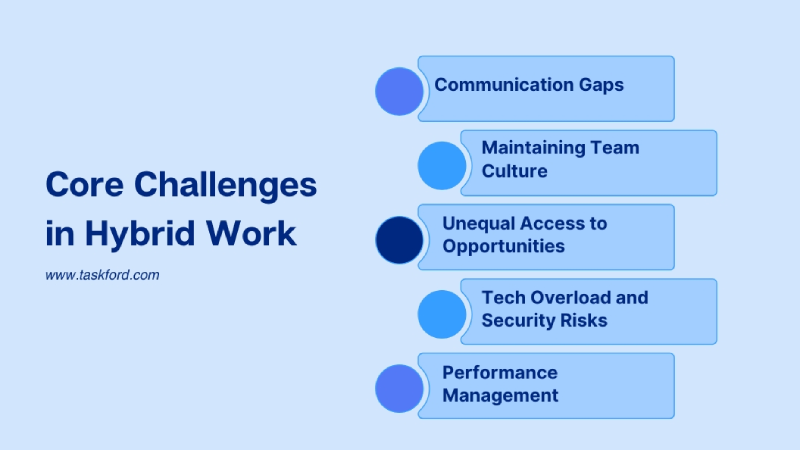
1. Communication Gaps
When teams are spread across locations, important updates can slip through the cracks. According to a report by Buffer, 20% of remote employees say communication and collaboration are their biggest struggles. Without strong communication systems, projects slow down, and misunderstandings arise.
2. Maintaining Team Culture
Company culture thrives on shared experiences, but hybrid setups can leave some employees feeling disconnected. A Microsoft Work Trend Index found that nearly 50% of leaders believe maintaining culture is harder in a hybrid environment. Keeping everyone engaged requires new strategies like regular check-ins and virtual team-building.
3. Unequal Access to Opportunities
Proximity bias is real; those who work more often in the office may get more visibility, leading to unfair advantages in promotions and recognition. Managers must find ways to measure performance based on outcomes, not presence.
4. Tech Overload and Security Risks
Hybrid work relies on multiple tools for meetings, messaging, and project tracking. Juggling too many apps can lead to inefficiency and burnout. At the same time, remote connections increase security risks, with cyberattacks rising 300% during the pandemic (Source: G6S Security).
5. Performance Management
Managing hybrid teams requires new metrics. Hours logged don’t show the full picture anymore. Instead, companies need to focus on goals, output, and collaboration quality.
Technology as the Hybrid Work Enabler
Hybrid work is only possible because of technology. It bridges the gap between remote and office-based employees, providing the foundation for productivity, collaboration, and security. But its role goes beyond simple connectivity; technology determines whether the hybrid workplace becomes an advantage or a challenge.
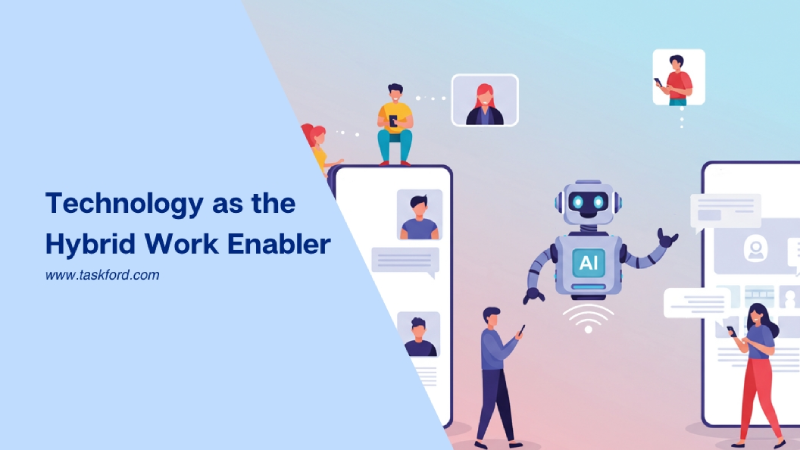
1. Enabling Seamless Connectivity
With employees working across different locations and time zones, communication must be instant and reliable. Digital platforms ensure teams can collaborate in real time, share updates, and make decisions without delays.
2. Creating Visibility and Structure
Hybrid models require centralized systems for managing projects, resources, and deadlines. Without them, work becomes fragmented. Technology provides a single source of truth, reducing confusion and improving accountability.
3. Safeguarding Data
Security is a major concern in hybrid environments where employees use multiple devices and networks. A 2023 IBM report found the average data breach cost reached $4.45 million, with remote work contributing to the risk.
To stay secure, companies need strong measures like multi-factor authentication, VPNs, zero-trust frameworks, and data encryption. Regular employee training is equally important to prevent phishing and human error.
Cybersecurity isn’t optional in a hybrid world; it’s essential for protecting data and maintaining trust.
4. Automation and AI
Automation reduces repetitive tasks, while AI offers predictive insights—such as identifying resource gaps or project risks early. According to Gartner, by 2026, 50% of organizations will use AI-driven collaboration tools to boost productivity. From chatbots that answer routine questions to predictive analytics for resource planning, AI enables teams to focus on high-value work. (Learn more about how AI helps you spot Project Risk early)
In short: Technology isn’t just a tool for hybrid work – it’s the strategic foundation that makes this model secure, scalable, and effective.
Team Dynamics in a Hybrid Environment
Hybrid work changes more than where people work; it changes how teams interact. With some employees in the office and others remote, creating a sense of unity can be challenging. Differences in communication styles, time zones, and work schedules can lead to gaps in collaboration if not managed well.

1. Avoiding the “Two-Tier” Culture
One common risk in hybrid work is proximity bias. Employees who spend more time in the office often receive more visibility and recognition than their remote counterparts. To prevent this, managers need to set clear performance metrics and focus on outcomes, not physical presence.
2. Building Inclusion and Trust
When teams are split, remote employees can feel disconnected. Regular check-ins, transparent communication, and inclusive meetings, where everyone has equal opportunity to contribute, are key to maintaining trust and engagement.
3. Supporting Well-Being
Hybrid work offers flexibility, but it can blur boundaries between work and personal life. Organizations should encourage healthy practices, such as no-meeting blocks and clear work-hour expectations, to avoid burnout.
4. Using the Right Tools for Connection
Digital collaboration platforms help bridge the gap between office and remote teams. Features like shared dashboards, integrated chat, and video conferencing ensure everyone stays aligned without endless emails or meetings.
Strong team dynamics in a hybrid model don’t happen by accident; they require intentional planning, inclusive practices, and tools that keep everyone connected.
Tools for Hybrid Work
Having the right tools is essential for making flexible work seamless. But success doesn’t come from using more apps; it comes from using the right ones that integrate well and support both remote and in-office employees. Here are the key categories:

1. Communication & Collaboration Platforms
Hybrid teams rely on real-time communication to stay connected. Tools like Microsoft Teams, Slack, and Zoom combine messaging, video calls, and file sharing in a single interface, reducing the need for constant emails and long meetings.
2. Project & Resource Management Solutions
Project and resource management platforms provide the structure needed to keep work on track. These tools bring together planning, task assignment, and progress tracking in one place, so teams, whether remote or in-office, stay aligned.
For example, TaskFord is designed as an advanced project management and resource planning solution that helps organizations handle these complexities with ease. It allows teams to:
- Plan projects with clear timelines and milestones so everyone knows what needs to be done and when.
- Allocate resources effectively, ensuring workloads are balanced and no one is overbooked.
- Track progress in real time through intuitive dashboards, reducing the need for constant status meetings.
- Keep collaboration connected with updates, files, and feedback linked to tasks, eliminating the need to switch between multiple tools.
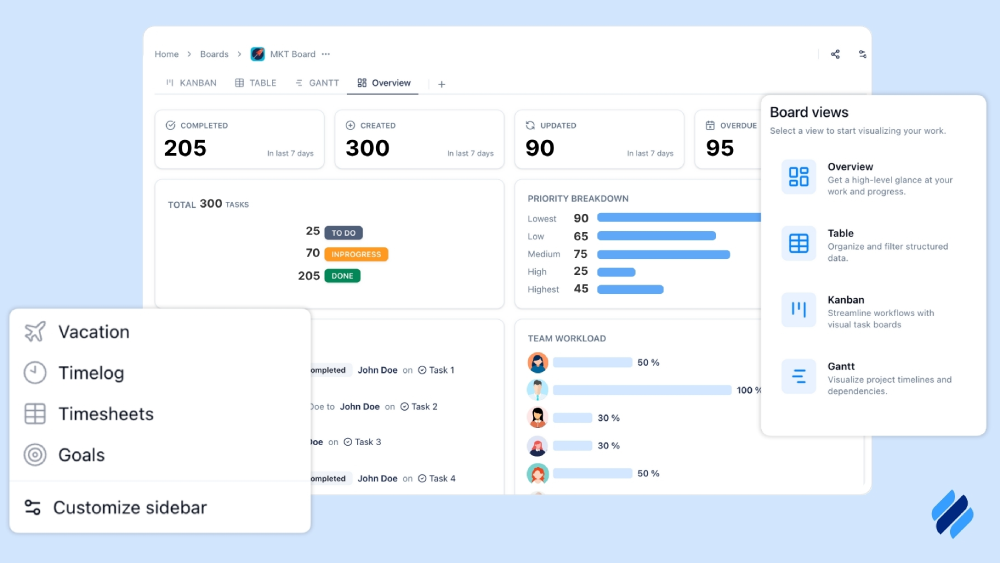
By centralizing these functions, TaskFord helps hybrid teams work more efficiently, stay aligned, and focus on outcomes rather than logistics.
3. Cloud Storage & Document Sharing
Access to files from anywhere is essential for hybrid work. Solutions like Google Workspace, Dropbox, and OneDrive allow employees to store, share, and edit documents collaboratively and securely.
4. Cybersecurity & Compliance Solutions
Hybrid setups require strong security. Tools like VPNs, encrypted storage solutions, and compliance-focused platforms help organizations protect sensitive data without sacrificing flexibility.
5. AI & Automation Tools
Automation reduces repetitive work, while AI predicts project risks and optimizes resources. From smart scheduling assistants to predictive analytics, these tools allow teams to focus on high-impact tasks rather than manual processes.
Key Takeaway: The best hybrid work tools are not about having more apps—they’re about integration. A well-connected system ensures smooth workflows, keeps teams engaged, and avoids the “tool overload” that can slow productivity.
Future Outlook: What’s Next for Hybrid Work?
Hybrid work is no longer a temporary fix—it’s a core part of how businesses operate. But the model is still evolving. As organizations refine their strategies, several trends are shaping the next phase of workplace flexibility:
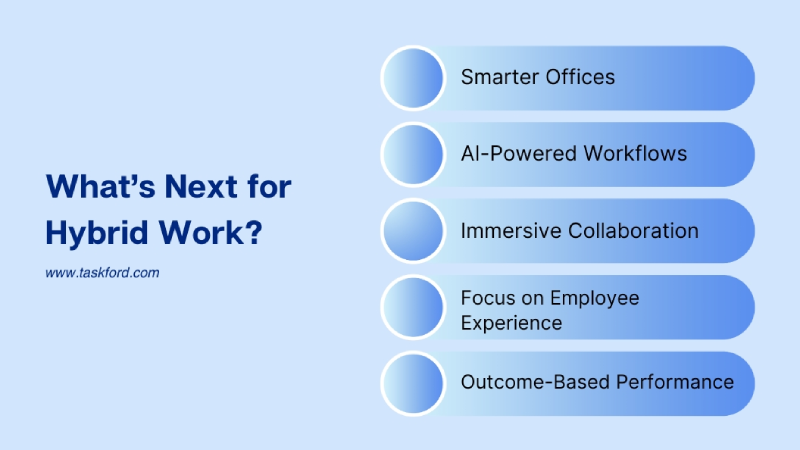
- Smarter Offices: Offices will transform into collaboration hubs, with hot-desking and flexible spaces replacing traditional desk layouts.
- AI-Powered Workflows: AI will predict risks, optimize resources, and automate repetitive tasks. Gartner predicts 50% of organizations will use AI-driven collaboration tools by 2026.
- Immersive Collaboration: AR and VR will make remote meetings more interactive, creating virtual spaces that replicate in-person experiences.
- Focus on Employee Experience: Companies will invest in well-being programs, digital wellness tools, and flexible policies to reduce burnout and improve retention.
- Enhanced Cybersecurity: Zero-trust security frameworks, data encryption, and compliance systems will become standard. IBM reports the average data breach cost hit $4.45 million in 2023.
- Outcome-Based Performance: Success will be measured by results, not hours logged – shifting from presence to productivity.
Conclusion
Hybrid work has moved from a quick fix to a permanent strategy. It offers flexibility and access to talent but also demands new approaches to communication, culture, and security. Success relies on integrated technology, outcome-based management, and tools that streamline work across locations.
As AI and automation reshape workflows and offices become collaboration hubs, businesses that adopt the right systems will stay ahead. Hybrid work is here to stay. The real question is: are you ready to make it work for your team?
Related Reading
- Top AI Cloud Business Management Platform Tools to Transform Your Project Management
- AI in project management - How AI is Revolutionizing Project Management: A Look at 2025 and Beyond
- Free Gantt Chart Software Comparison for 2025
Making work simpler,
smarter, and more connected
Join our waitlist and be notified first.

Related Blog
Subscribe for Expert Tips
Unlock expert insights and stay ahead with TaskFord. Sign up now to receive valuable tips, strategies, and updates directly in your inbox.






